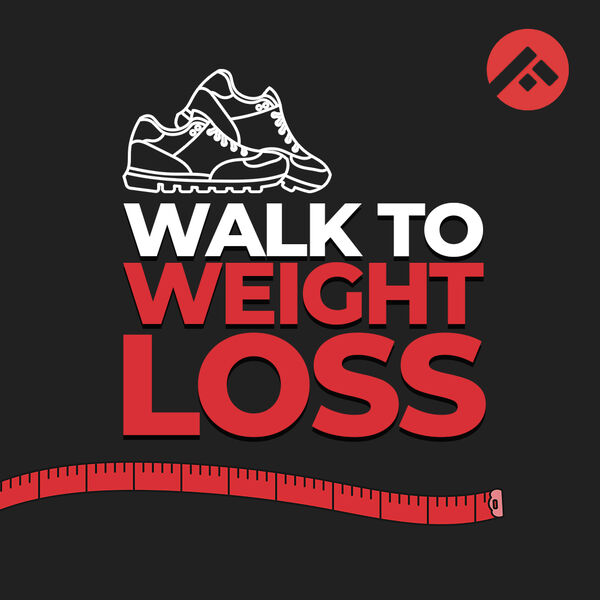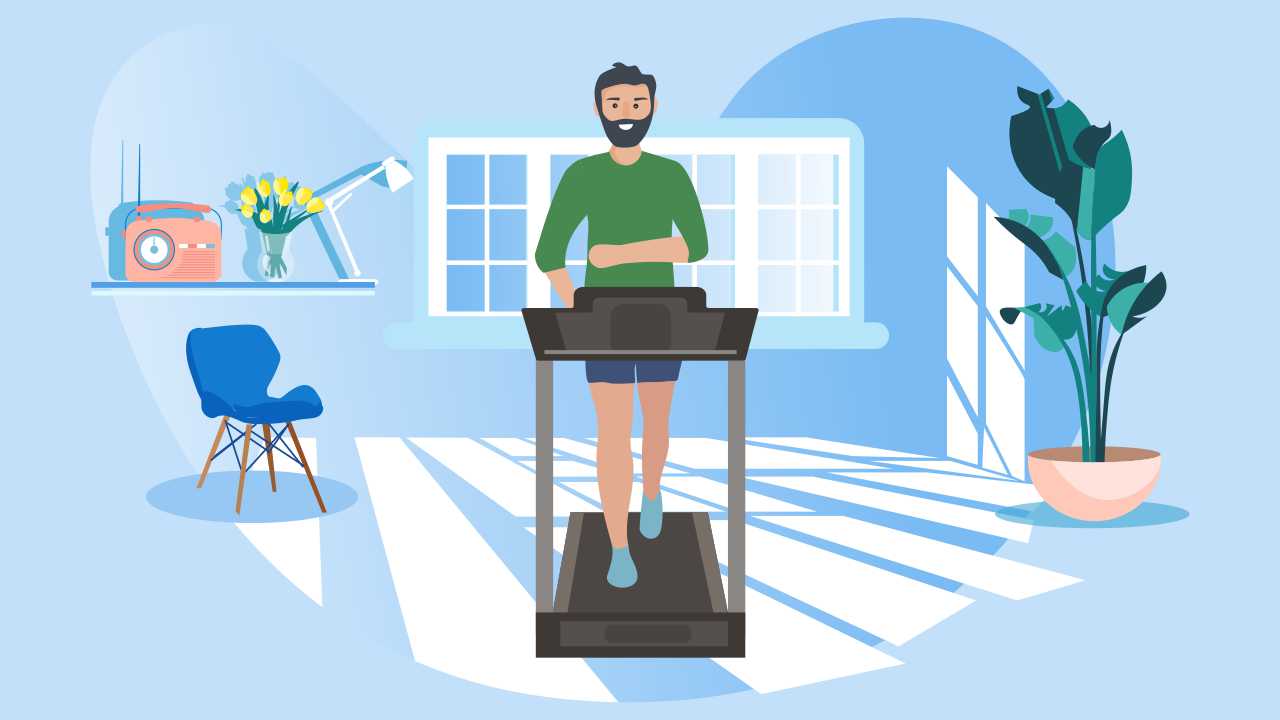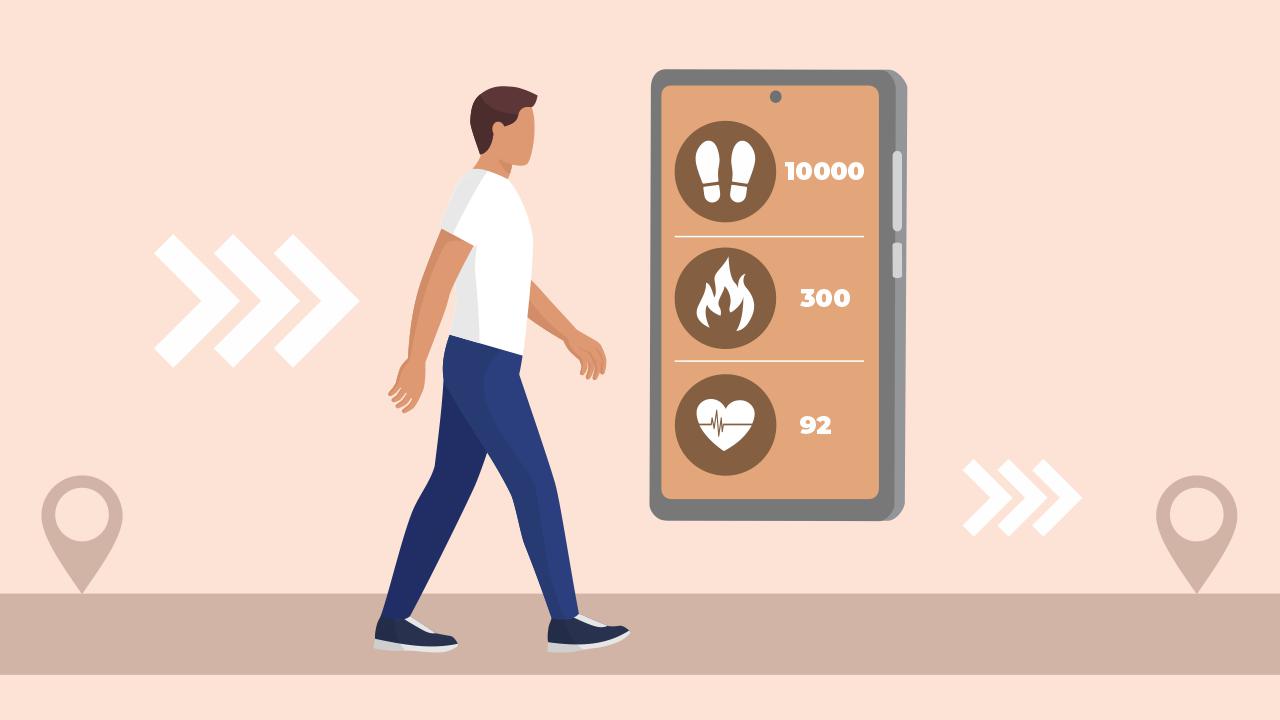
How to Plan Your Walks

Walking is a common bipedal activity that does not need any upskilling to perform. You may just put on a pair of walking shoes and get started. Walking is one of the most cost-effective modes of exercise, requiring minimal equipment and space.
Walking for transportation is one way to accumulate physical activity as part of a daily routine, which has prompted research to look closely at the health benefits of this exercise. Many research papers have indicated that walking offers a wide range of cardiovascular, metabolic, and musculoskeletal health benefits when done particularly at higher paces/intensities and greater relative heart rate zones. Walking appears to share a dose-response inverse relationship with cardiovascular disease risk — put simply, the greater the total volume of weekly walking, the lower the risk of cardiovascular diseases.
Some evidence has indicated that walking two hours per week can reduce the relative risk of coronary heart disease in women by 50%. One systematic review by Boone-Heinonen and colleagues in 2008 established that cardiovascular disease risk decreased incrementally with higher walking durations, greater distances, and higher overall energy expenditures.
In addition, Murtagh and co’s meta-analysis in 2015 showed that walking improved aerobic fitness by 10.5% and systolic (by -3%) and diastolic blood pressure ( by -2%).
Qui and colleagues in 2014 also showed that more than eight weeks of walking produced significant improvements in hemoglobin A1c levels in people with type-II diabetes. The hemoglobin A1c test measures the amount of blood sugar (glucose) attached to hemoglobin, and so a lower score of approximately 0.5% is a meaningful change for people with type-II diabetes.
Altogether, it seems that walking is highly beneficial for a variety of health outcomes and may prove a vital exercise strategy for those particularly at risk of cardiovascular or metabolic disease.
Like all forms of exercise, walking requires commitment. Cardiovascular adaptations typically take anywhere between three to 12 weeks, depending on the type of aerobic activity undertaken, as well as the frequency and intensity of the exercise. Longer aerobic exercise durations are generally associated with greater cardiovascular health outcomes for healthy younger and older adults as illustrated below.
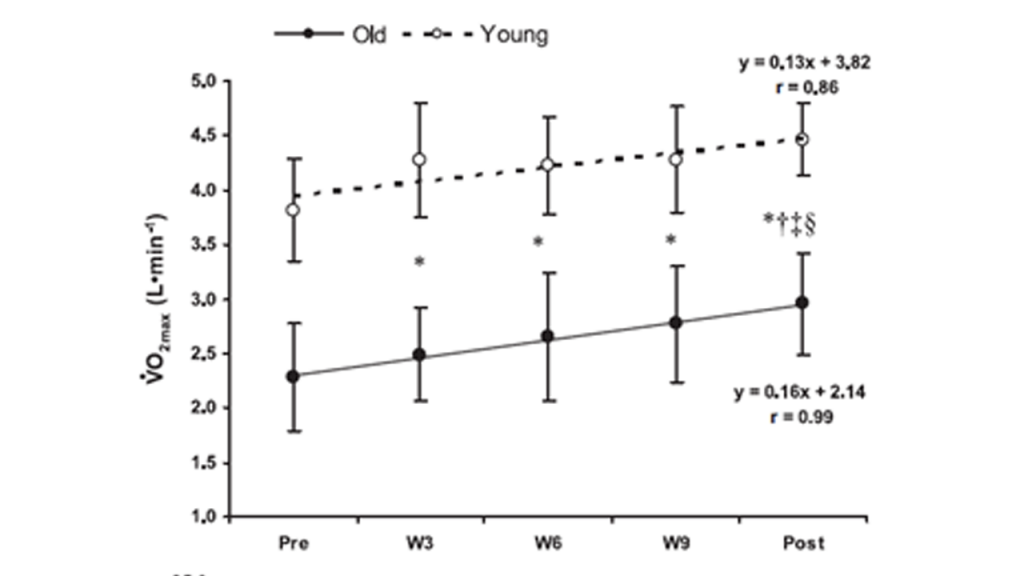
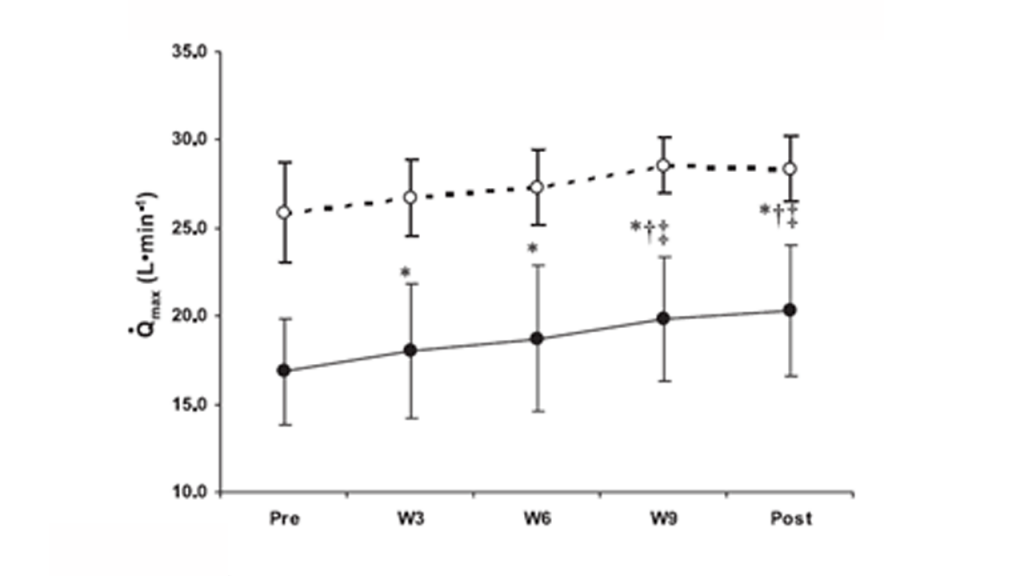
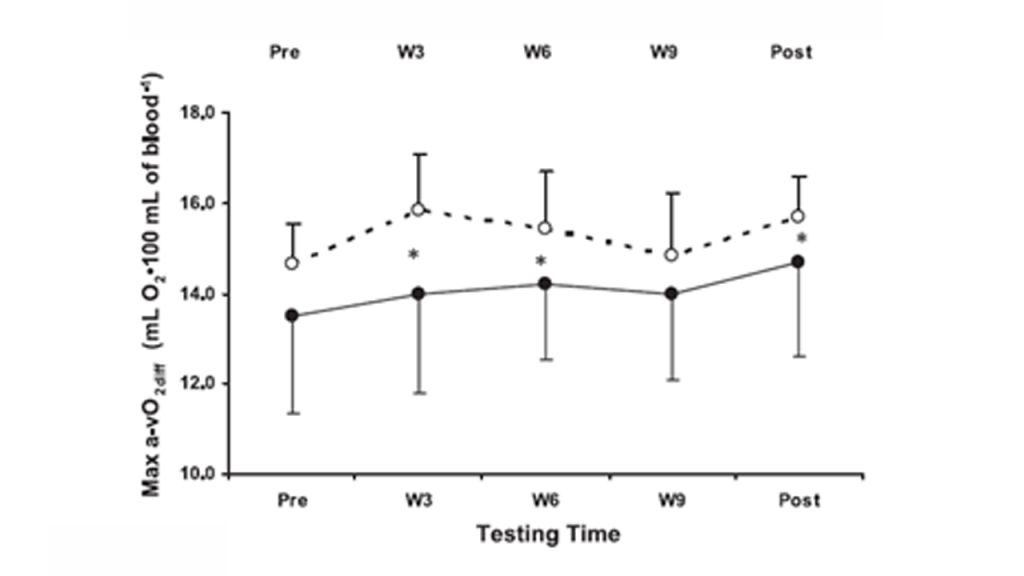
*Significantly different from pre-training values (p<0.05). † Significantly different from week 3 (W3) (p<0.05). ‡ Significantly different from week 6 (W6). § Significantly different from week 9 (W9)
In general, though, it must be noted that walking needs to be of at least moderate intensity (64%-76% HRmax) to improve aerobic fitness levels, with evidence demonstrating even greater fitness improvements obtained from walking at vigorous intensities (77%-93% HRmax).
For walking-based physical exercise, the recommendation is approximately 30 minutes/day, on five days of the week to elicit aerobic health benefits, which translates to around 2.5 hours and 7.5 Metabolic Equivalents (MET)/hour of walking per week, assuming a 3 MET walking pace. MET is a ratio of one’s working metabolic rate relative to resting metabolic rate. Metabolic rate is the rate of energy expended per unit of time, and so at rest this is equivalent to 3.5ml of oxygen (O2) consumed per kilogram of body weight, every minute. So, an activity with an MET value of 3 means that one is exerting thrice the energy, ie, approximately 10.5 ml of O2 per kilogram of body weight compared to sitting still.
For a detailed description of the different categories of METs activities, see Table 1.
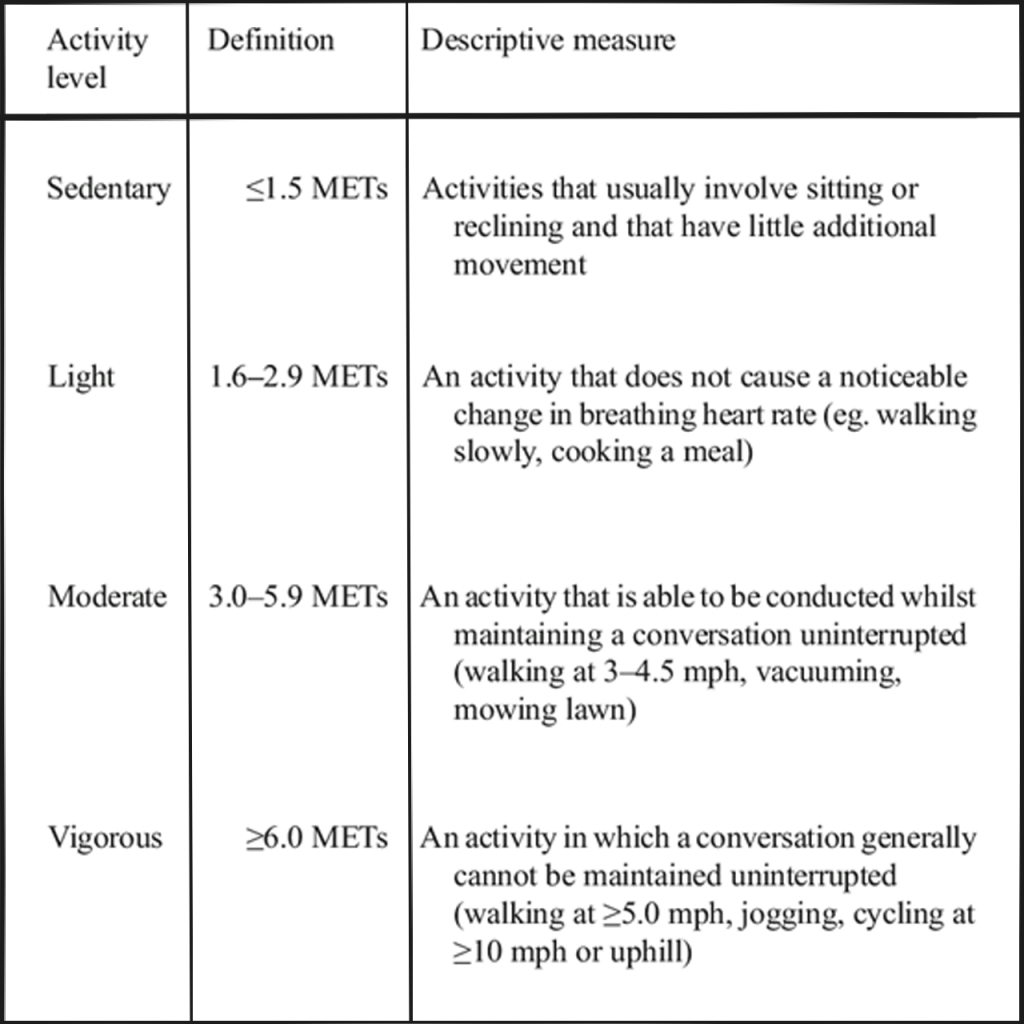
Why is it important to plan your walks?
Numerous epidemiological studies have observed increasingly worrying trends regarding the physical activity levels of South-Asian adults and older adults. The primary concern is that people, particularly across India, Sri Lanka, and Pakistan, don’t engage in the minimum required dose of physical activity to be classed as healthy, with many studies reporting inactivity levels within their sample population ranging between 400 to 7,000 people. This percentage is in excess of 50%, with some inactivity rates as high as 75% among certain population groups.
Lifestyle barriers, lack of access to appropriate outdoor exercise spaces, cultural beliefs, socioeconomic circumstances, work stress, education, and many other factors may limit a person’s physical activity levels. Thus, it is critical to plan for exercise within a weekly schedule, so it becomes part of the daily/weekly routine. Having a consistent plan, with walking factored into the standard weekly routine, may help overcome some of the barriers faced to exercising.
Factors to consider while planning your walks
The key to any training plan is adhering to the FITT principles; that is, Frequency (F), Intensity (I), Time (T), and Type (T). Table 2 outlines a good plan for a beginner walker using the FITT principles to guide the planning process.
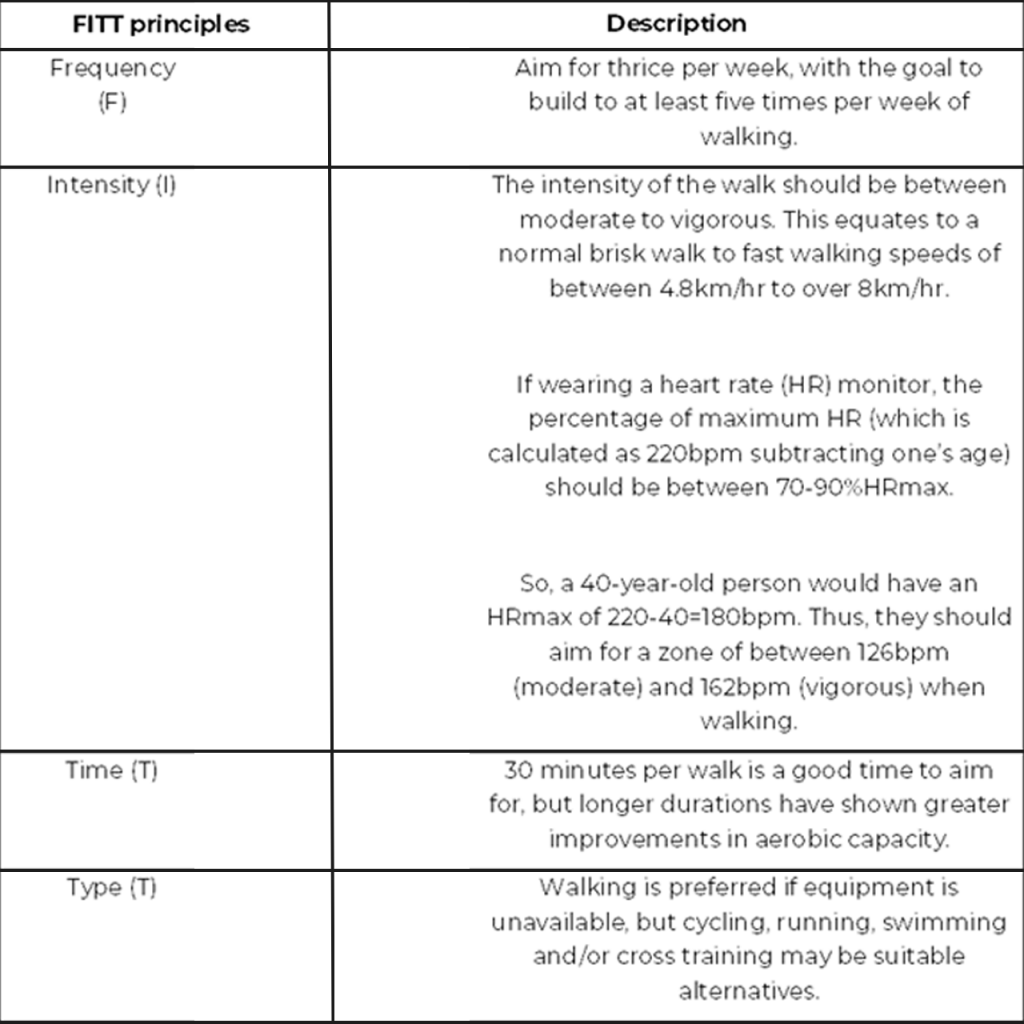
If an HR monitor is unavailable, the Borg Rating of Perceived Exertion (RPE) scale and Talk Test comparison is a good way to evaluate walking intensity. The following table (Table 3) is a good way to measure one’s walking exertion level.
Also read: How to Train Progressively to Walk Longer
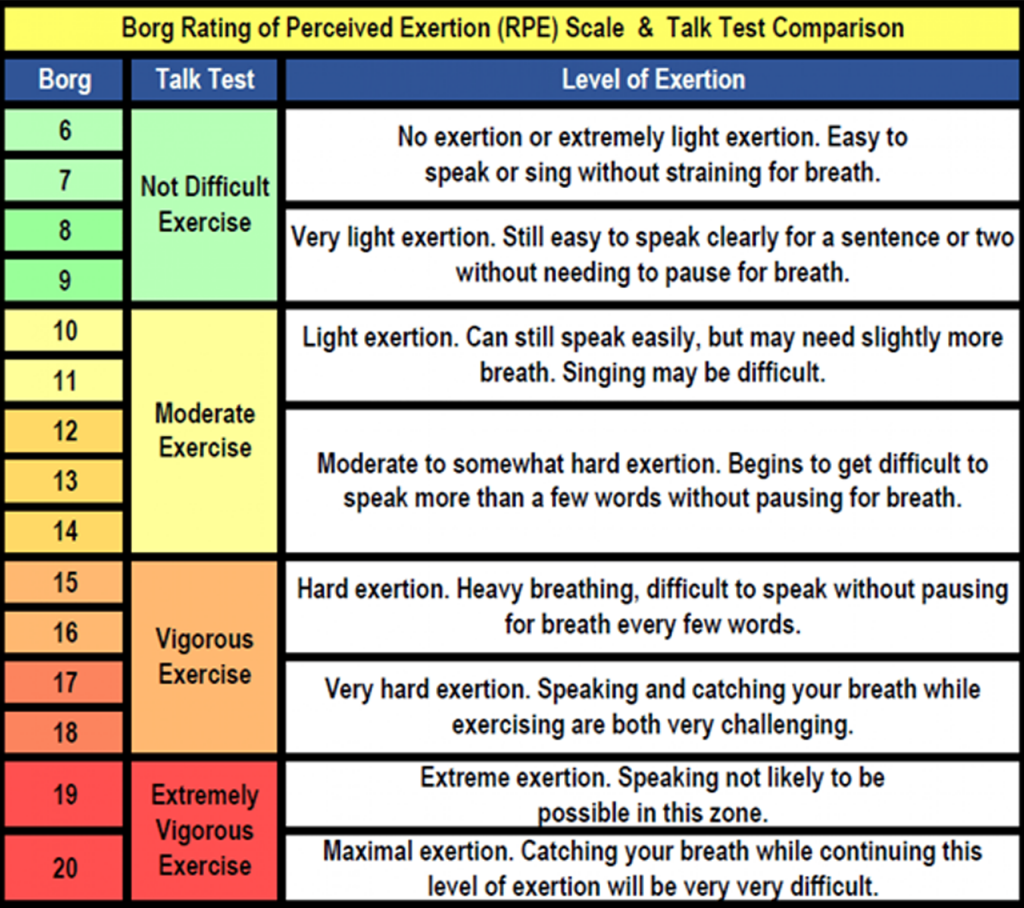
How to start a walking routine and progress with it
Here are a few goals for beginner walkers along with strategies for progressing walking-based exercise across other categories like intermediate and advanced walkers.
Beginner
- Try walking briskly at a pace of 4km/hr to 4.5km/hr, covering a kilometer in 15 minutes. Begin with 10 minutes per day for the first three weeks.
- Increase the duration gradually by 5 minutes per week until you can walk 30 minutes per day, five to six days per week
Intermediate
- Start at this level if you are already in good shape. If not, then you may get to this level after about a month of the beginner program.
- Aim for a walking speed ranging between 5km/hr to 7.5km/hr. So, you can walk at a pace ranging between 8 minutes/km to 12 minutes/km.
- Walk 3km to 4km for about 48 minutes at a 12-minute/km pace, three-five times per week. If you find that you can’t walk that fast, then increase the distance that you walk instead of increasing the pace.
Advanced
If you are already into fitness walking and in an excellent shape, then follow these tips to raise your workout intensity:
- Walk/hike with a 5kg-7kg backpack
- Add uphill/downhill and stair climbing to your regular walks
- Use 1kg-3kg hand weights and continue your arm swing motion
- Try racewalking at a speed exceeding 10mph to increase the intensity of your walks
Tips to plan a walking-routine focusing on weight loss
Typically, any weight loss plan needs to be supplemented with appropriate calorie deficits by adjusted macronutrient quantities, in addition to an exercise intervention — be it running, walking, or resistance training. As such, walking alone may be insufficient as a weight loss strategy. But walking in conjunction with diet change and resistance or high-intensity interval training modes may be highly favorable for eliciting body fat percentage changes (reductions) and improved lean muscle mass. For any walking-based weight loss program, the desired goals are the same as mentioned in the FITT principles.
Also read: How to Walk Faster: Tips and Techniques
Overall, walking is cost-effective, easy to perform, and has been shown to improve several cardiovascular, metabolic, and musculoskeletal health outcomes. Regular walking can also reduce chronic pain symptoms and overall quality of life and cognitive function. Increasing walking durations to over 30 minutes at moderate to vigorous intensities for more than three weeks (walking five times per week) may also result in a noticeable weight loss. However, several barriers may limit the amount of time spent actively engaging in walking-based exercise. So, careful planning and goal setting is critical to ensure walking becomes a uniform part of your weekly activity.
References
1. Murtagh EM, Murphy MH, Boone-Heinonen J. Walking–the first steps in cardiovascular disease prevention. Current Opin Cardiol 2010; 25: 490-6.
2. Boone‐Heinonen J, Evenson KR, Taber DR, et al. Walking for prevention of cardiovascular disease in men and women: a systematic review of observational studies. Obesity Rev 2009; 10: 204-17.
3. Qiu S, Cai X, Schumann U, et al. Impact of walking on glycemic control and other cardiovascular risk factors in type 2 diabetes: a meta-analysis. PloS One 2014: 9.
4. Murtagh EM, Nichols L, Mohammed MA, et al. The effect of walking on risk factors for cardiovascular disease: an updated systematic review and meta-analysis of randomised control trials. Prev Med 2015; 72: 34-43.
5. Murias JM, Kowalchuk JM, Paterson DH. Time course and mechanisms of adaptations in cardiorespiratory fitness with endurance training in older and young men. J Appl Physiol 2010; 108: 621-7.
6. American College of Sports Medicine. ACSM’s Guidelines for Exercise Testing and Prescription 9th ed 2013. Philadelphia: Lippincott Williams & Wilkins, 2013.
7. Verschuren O, Mead G, Visser-Meily A. Sedentary behaviour and stroke: foundational knowledge is crucial. Translational Stroke Res 2015; 6: 9-12.
8. Donnelly JE, Blair SN, Jakicic JM, et al. American College of Sports Medicine Position Stand. Appropriate physical activity intervention strategies for weight loss and prevention of weight regain for adults. Med Sci Sport Exerc 2009; 41: 459-71.
9. Bond Brill J, Perry AC, Parker L, et al. Dose–response effect of walking exercise on weight loss. How much is enough?. Int J Obes Relat Metab Disord 2002; 26: 1484-93.
10. O’Connor SR, Tully MA, Ryan B, et al. Walking exercise for chronic musculoskeletal pain: systematic review and meta-analysis. Arch Phys Med Rehabil 2015; 96: 724-34.


